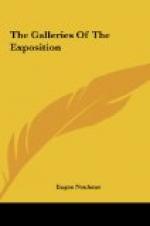Here Metcalf’s “Blossom Time” reveals the most poetic of our modern American painters. The man who bought it made a good investment. In ten years it will be a classic and worth its weight in gold, including the frame. This canvas gives one more thrills than almost all the others by the same man — good as they are. The “Trembling Leaves” is superb, but a fussy frame destroys half the pleasure. Mrs. Philip Hale’s elegant and refined interior, together with Paxton’s figural work, prove that we have conquered successfully a certain field of genre which the American art-lover has been in the habit of buying in Europe. Paxton’s “Housemaid” is entirely in the spirit of the old Dutch, and his “Bellissima” is most luminous alongside of his other works.
Gallery 51.
This magnetic collection comes somewhat as a shock to the public, which can’t be blamed for its disapproval of the recent sensational experiments of Henri and Glackens. It is impossible to understand why a man like Glackens should so illogically abandon the soundness of his older work and do those inharmonies of form and colour which he presents on the A wall. His “Woman with Apple” is absolutely absurd and vulgar beyond description. She has “character,” if that is what he is after, because her vulgarity is convincing. The rest of the things are ridiculous in their riotous superficiality. Carles seeks the same expression of individuality for which Glackens strives so hard. In his small, square picture, “Repose,” Carles is most successful. Here he has created a great work of art — beautiful as well as full of character. This canvas is one of the most successful of the new style. It needs no apologies, and it has all the qualities of an old master, with modern virility and colour added to it. Let us have new things like this and we shall not regret having tolerantly and patiently watched all the many idiocities which are paraded around under the pretext of research and experimentation. Breckenridge’s still-lifes are startling at first, but studied singly they reveal a fine sense of colour. They constitute a serious and successful contribution to modern art, without being in the least grotesque. I should like to have one of them in my house, without fear of their very vigorous colour. In a totally different vein Everett L. Bryant gives some still-lifes which continue certain impressionistic methods with wonderful delicacy. In certain surroundings they will add distinction even to a commonplace room. Anshutz’s “Lady in Red” is a very good academic study in a colour which in large quantities is very difficult to handle.
Gallery 50.
The academic school is continued in spirit in Sergeant Kendall’s refined portraits, augmented by a painted wood sculpture of unusual quality, reminiscent of the masters of the early German Renaissance. Louis Kronberg has his customary ballet girl and Hermann Dudley Murphy some of his typical, refined marines. His surfaces are always delectable and like the inside of a shell in their glistening blues and pinks. Both Nelson and Hansen, two native Californians, are well represented — one by a Monterey coast, the other by a forcefully painted decorative picture called “The Belated Boat.” Lathrop adds two placid pictures, of which the canal is the more skillfully composed.




